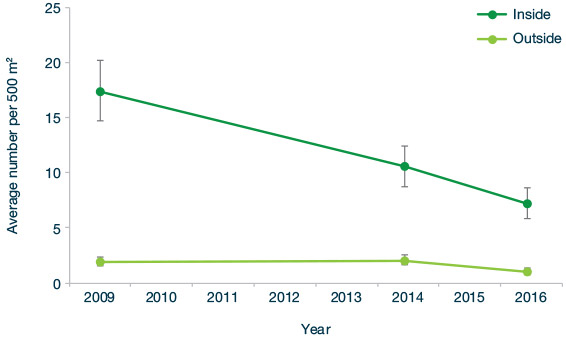Rock lobster levels in Tāwharanui Marine Reserve
Introduction
How many rock lobster (crayfish/kōura) are present in Tāwharanui Marine Reserve and how are their numbers changing?The Hauraki Gulf attracts commercial and recreational fishers from nearby urban areas, including Auckland and Whangarei. Fishers target rock lobster (Jasus edwardsii), snapper and other reef fish.
Number of rock lobster inside and outside Tāwharanui Marine Reserve

Status: undetermined
In 2009 the average number of rock lobster per 500m2 inside the marine reserve was 9 times higher than outside the marine reserve. In 2016 the average number of lobster per 500m2 inside the marine reserve was 7 times higher than outside the marine reserve.
Natural levels of rock lobster in the marine reserve are uncertain, so their status cannot be assessed at this time.
Note: Graphed results show the average number per 500m2 (± standard error) of rock lobster of all sizes, including those smaller than the legal size. This dataset is from 2009 to 2016. Data from longer term monitoring is not comparable with this data and is not shown.
Trend: declining
There has been a decline in the average number of rock lobster per 500m2 in the last 7 years. The monitoring survey in 2009 recorded 2.5 times as many rock lobster per 500m2 than the 2016 survey.
A similar declining trend has been observed at nearby Cape Rodney-Okakari Point Marine Reserve for 10 years.
Snapper
Data analysis to derive the status and trend of snapper at Tāwharanui Marine Reserve is underway. It is not included in this report card.
Reports
- Cape Rodney-Okakari Point Marine Reserve and Tawharanui Marine Park fish monitoring: UVC survey autumn 2011. Haggitt, 2011.
- Long-term trends in lobster populations in a partially protected vs. no-take marine park. Shears et al, 2006.
- Spiny lobster, Jasus edwardsii, recovery in New Zealand marine reserves. Kelly et al, 2000.
